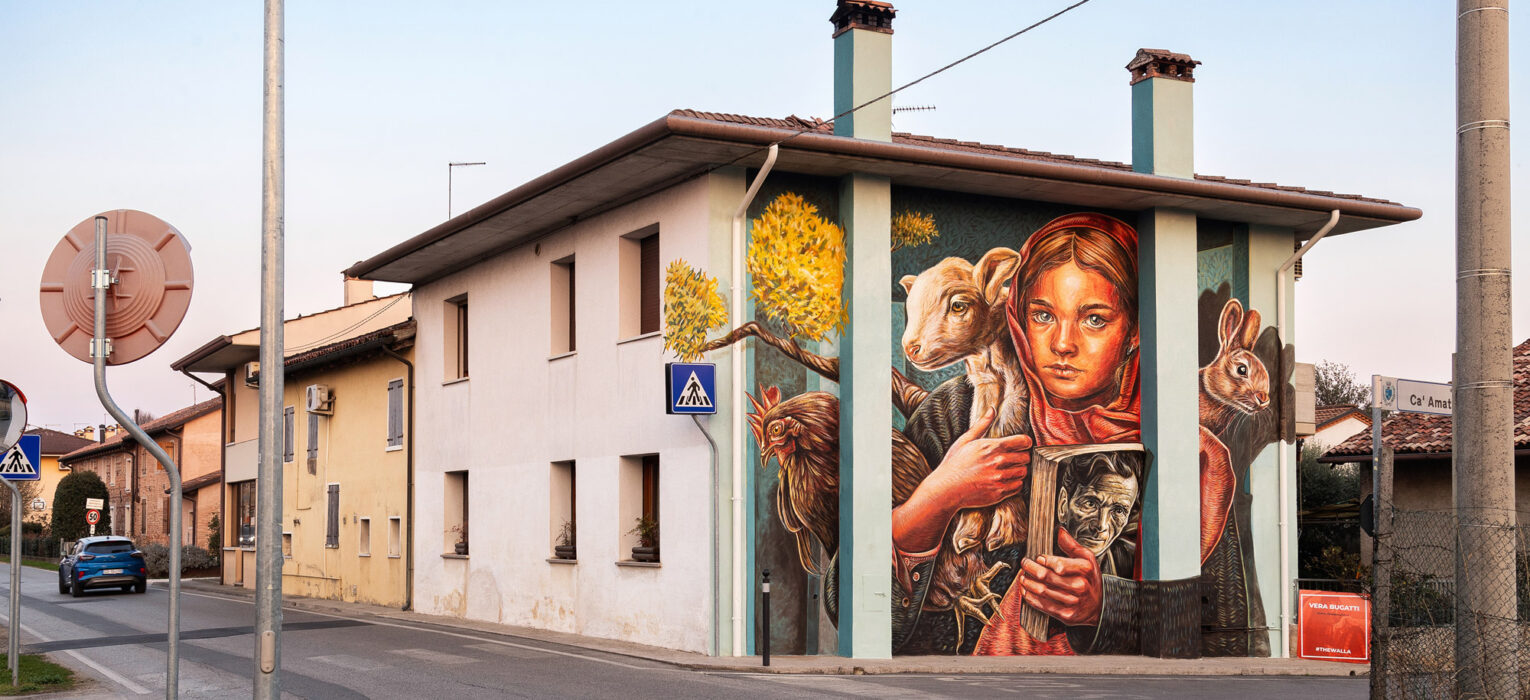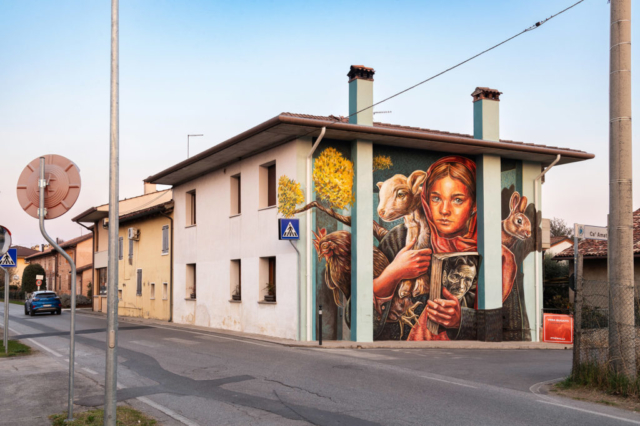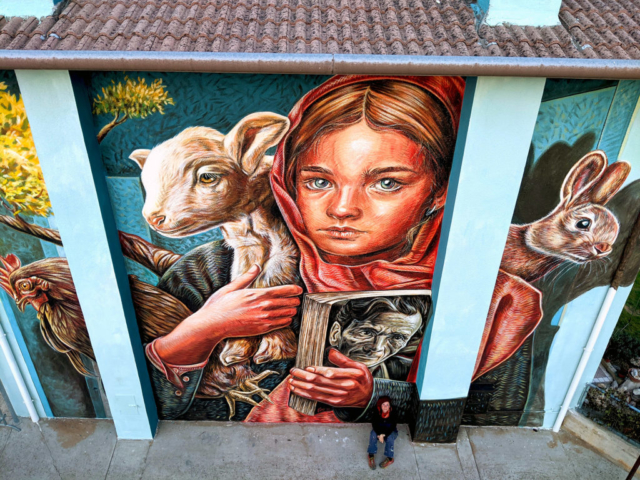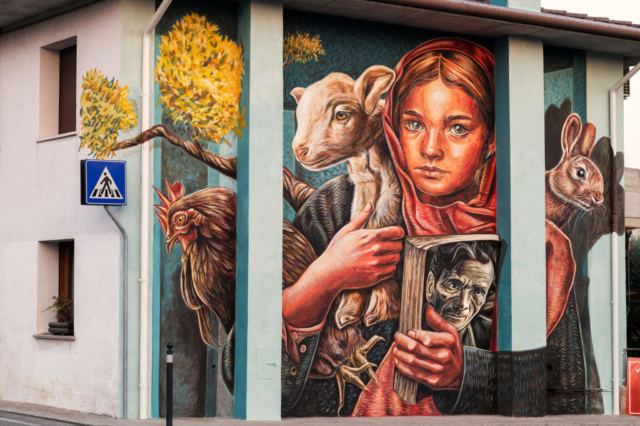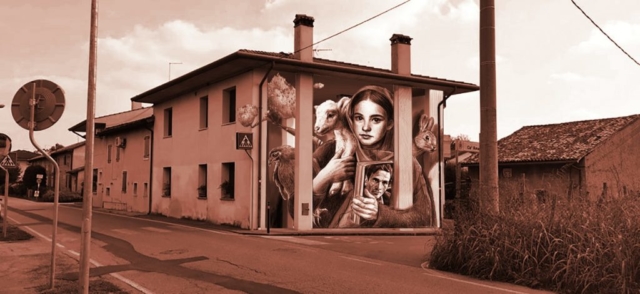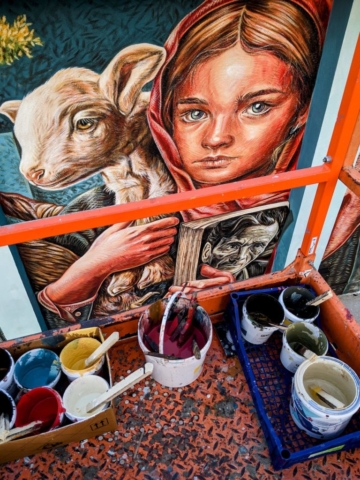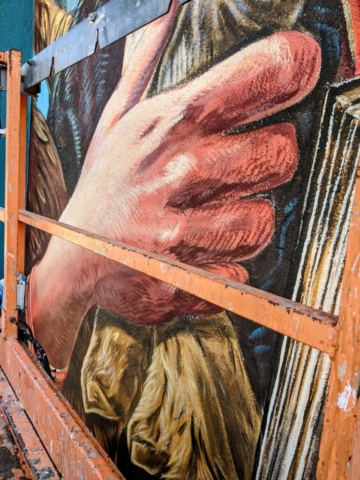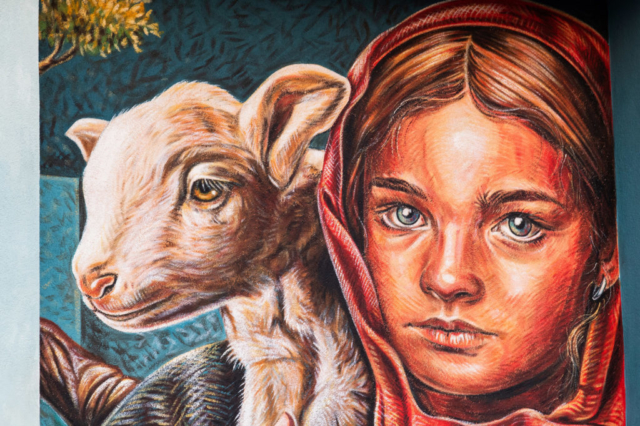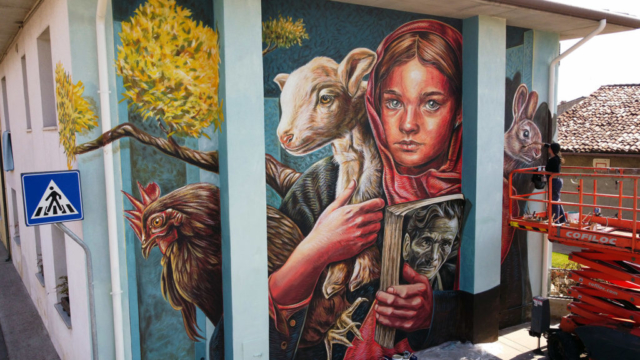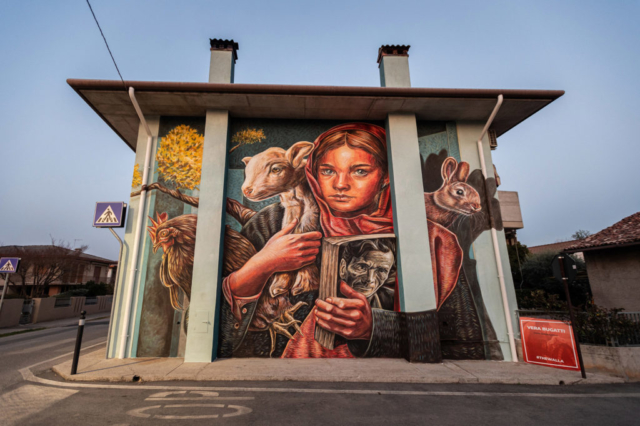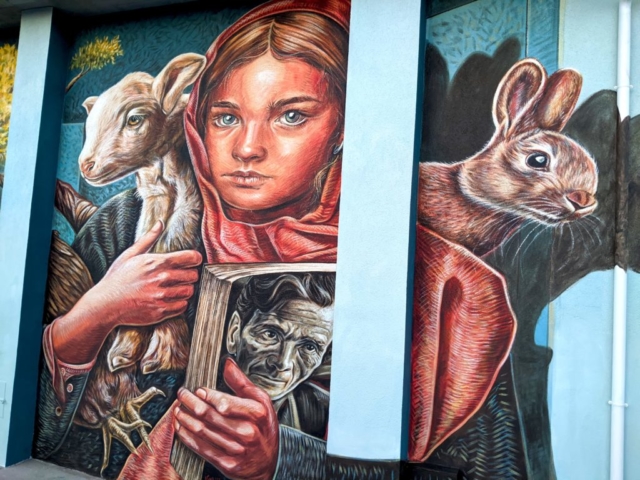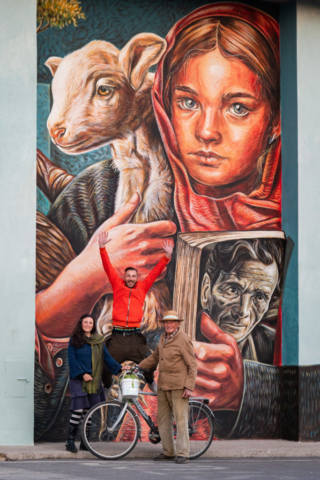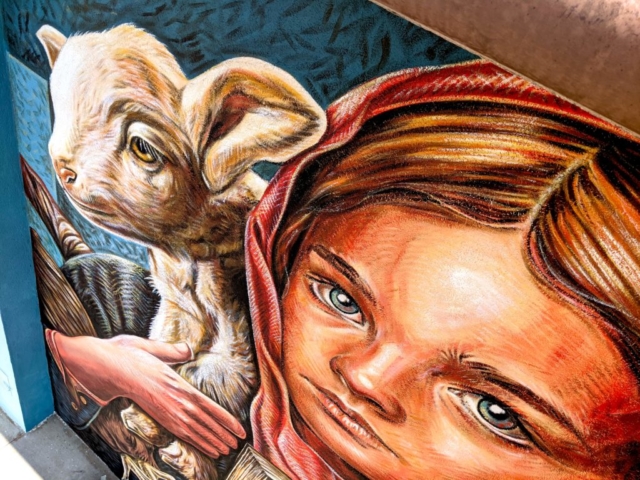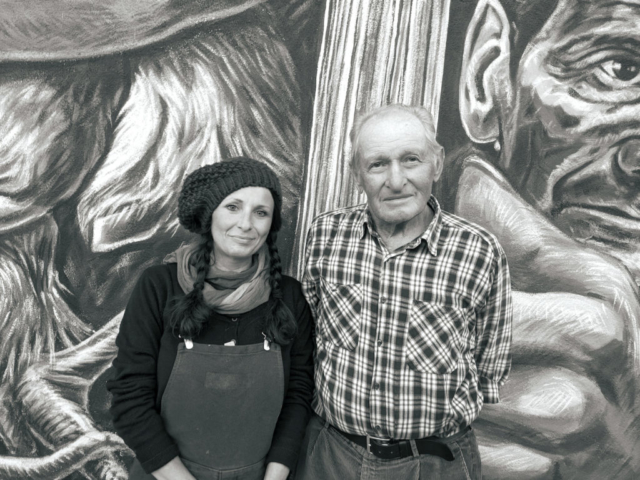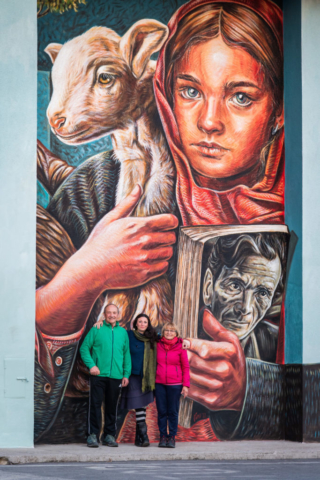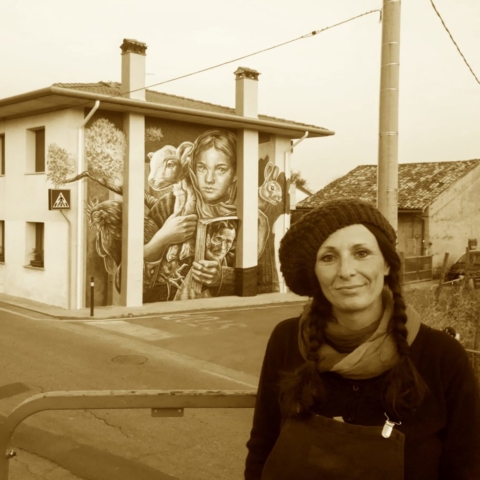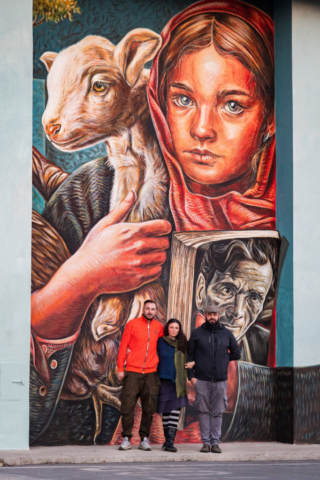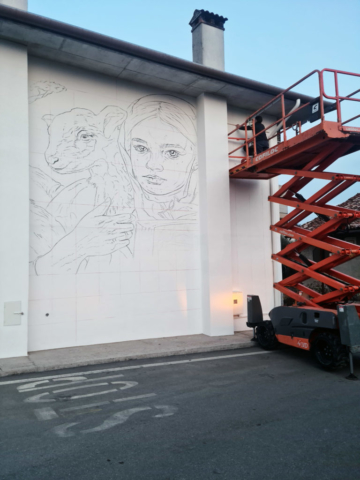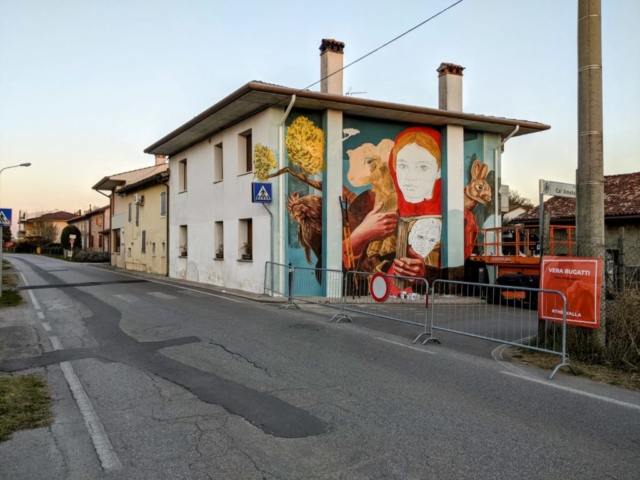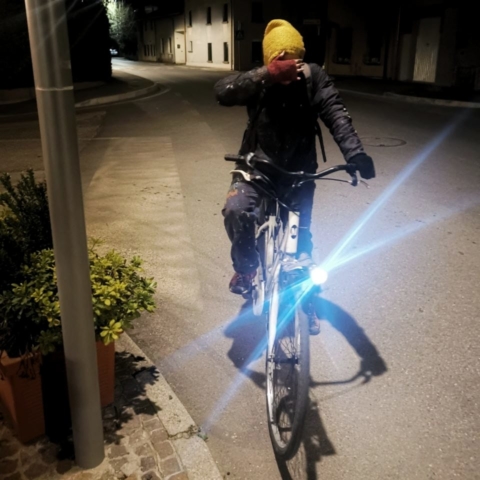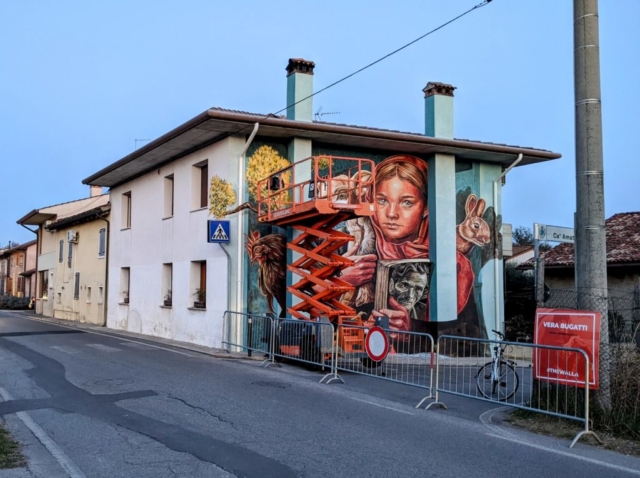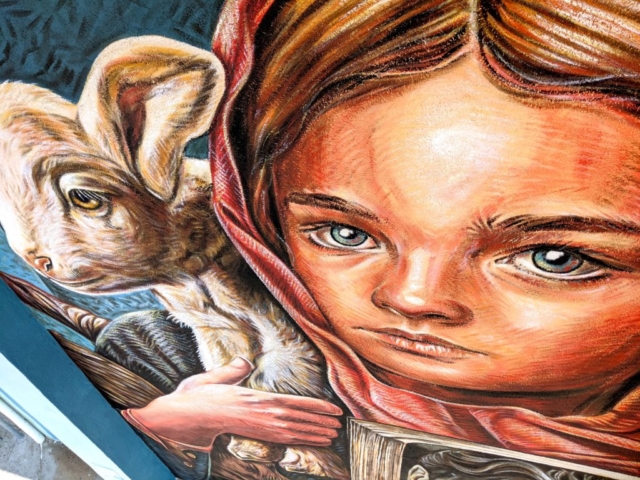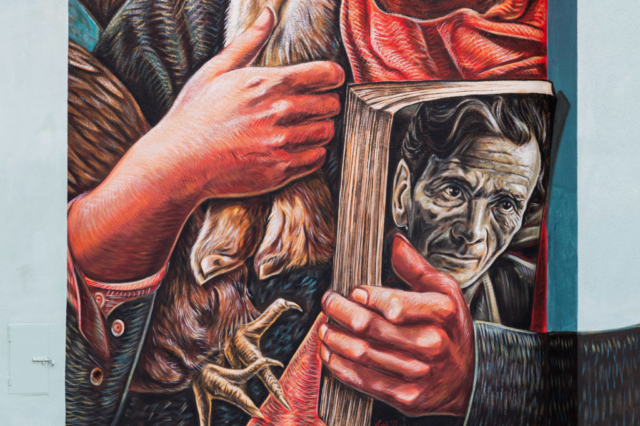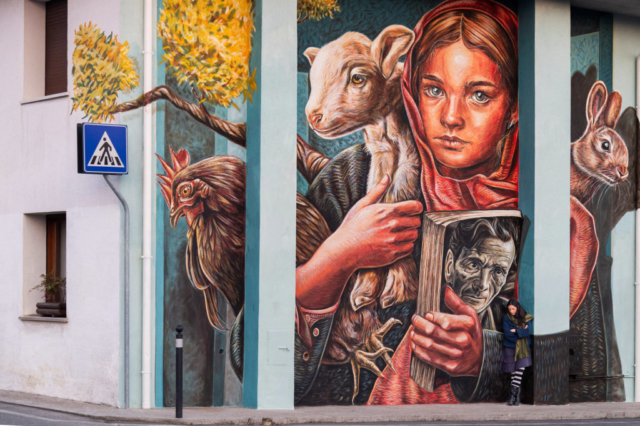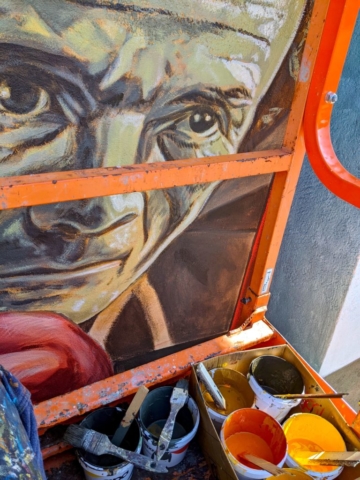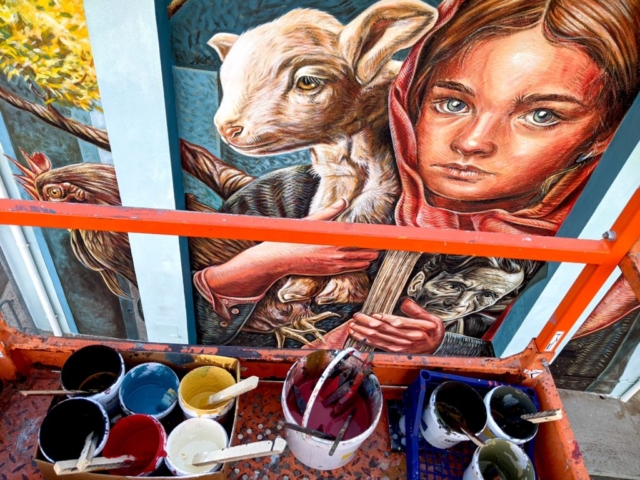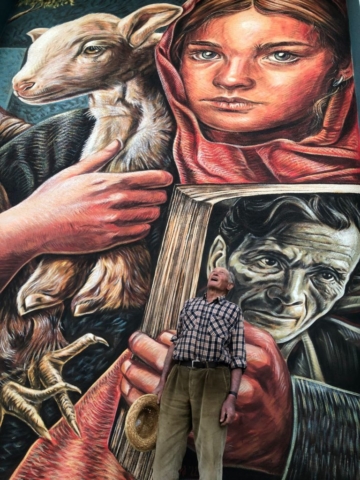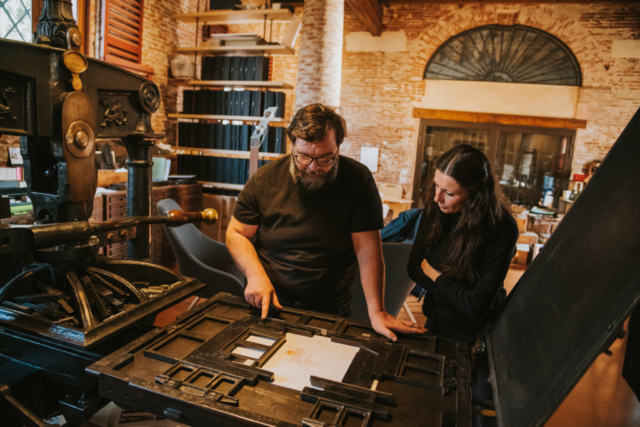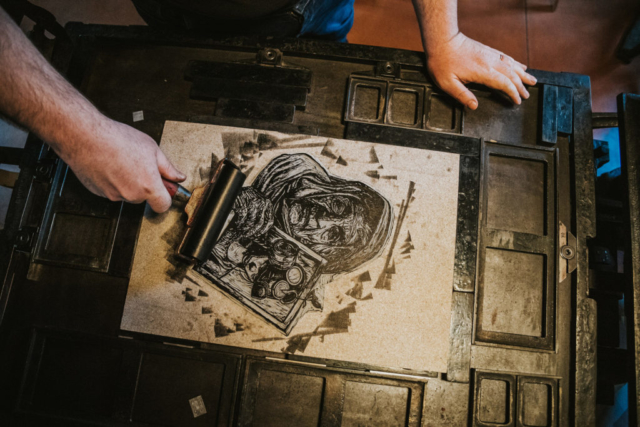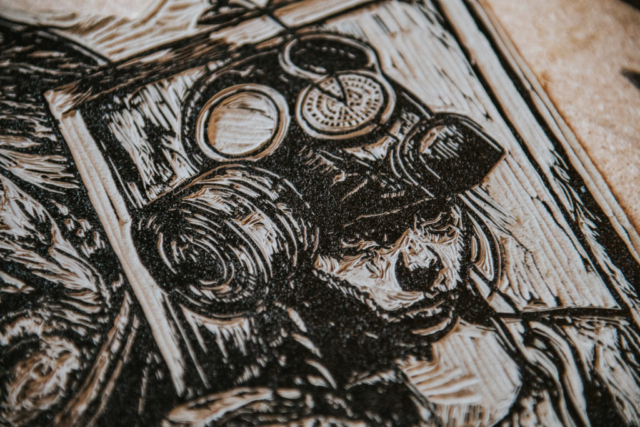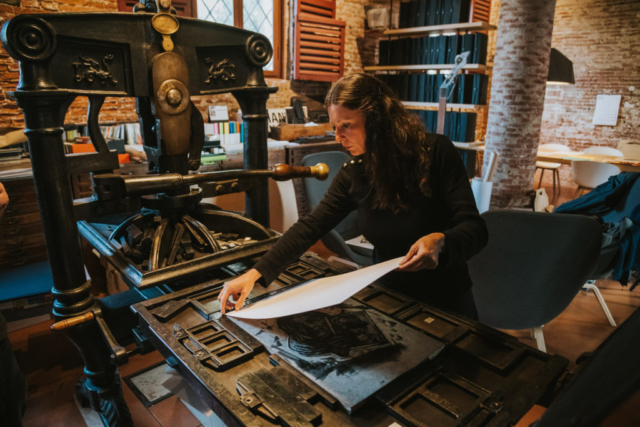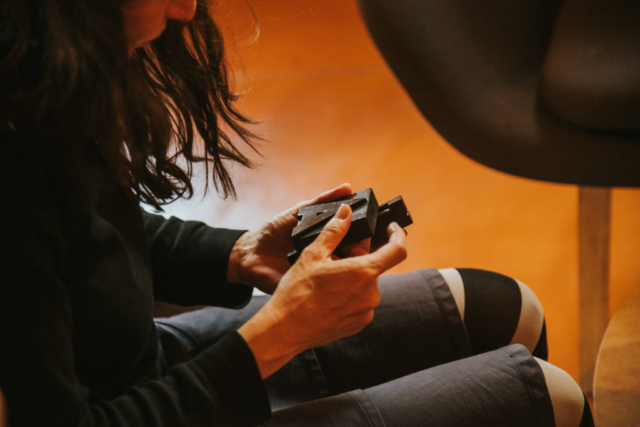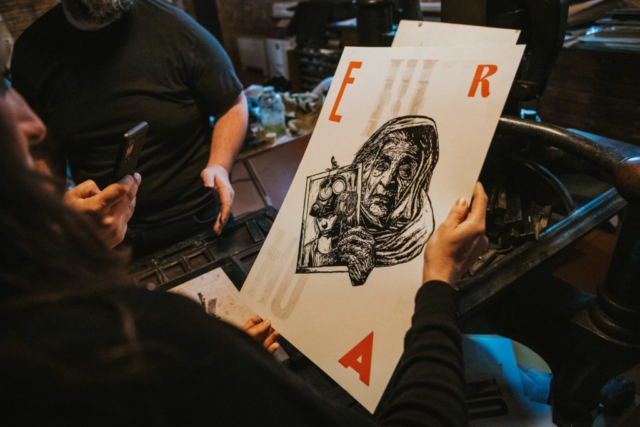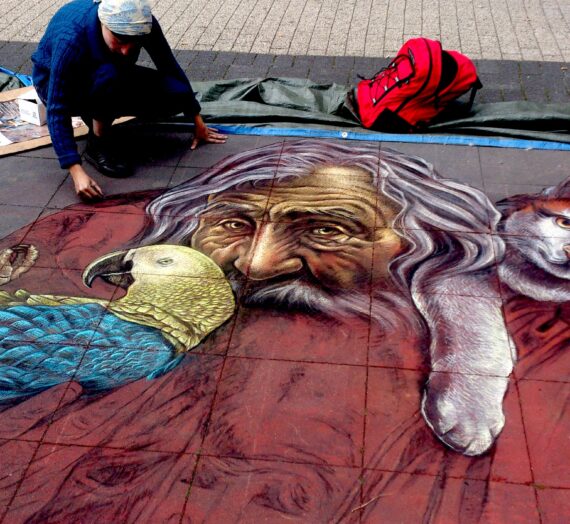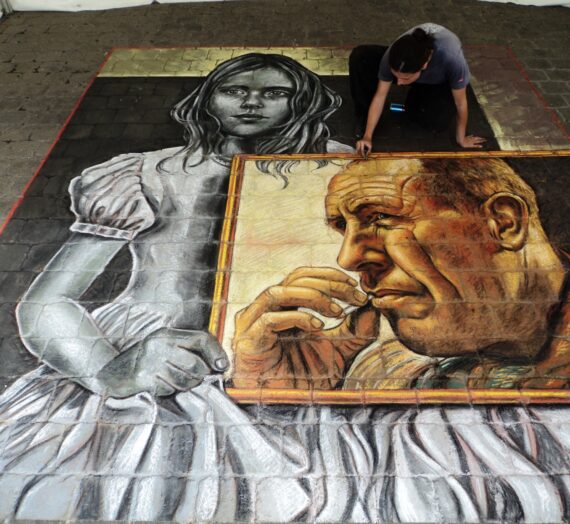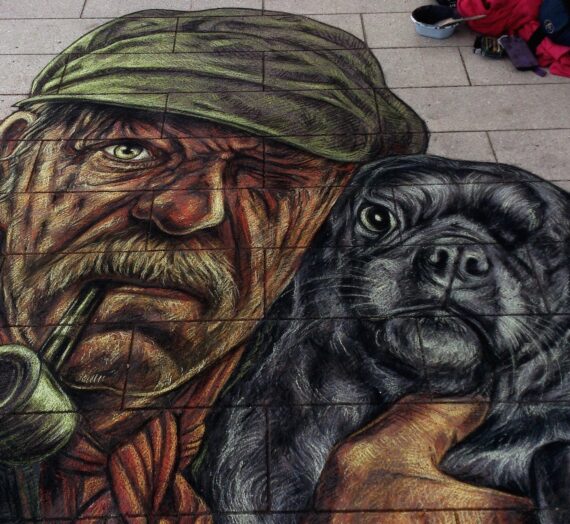Vi racconto brevemente de L’Ostinazione, opera realizzata in marzo a Vallà di Riese (TV) all’interno del Festival di arte urbana The Wallà edizione 2022.
Sei mesi prima ero stata contattata da Yuri, dell’Associazione BocaVerta, che mi aveva raccontato del progetto del suo collettivo e delle prime pareti realizzate così come dell’idea di far esondare il festival dai muri alle stampe d’autore creando un parallelo “thewalladicarta” che lasciasse un ricordo indelebile del passaggio dei vari artisti.
Dopo le ultime installazioni in luoghi abbandonati, che tanto fanno bene al mio spirito quando il corpo non brilla, ero pronta (o quasi) per tornare sulla piattaforma aerea.
Convinta che avrei dovuto affrontare, dopo due mesi di siccità, piogge torrenziali, sono partita attrezzata come se avessi in programma di guadare il Noguera Pallaresa e invece sono stata accolta da un clima mite e secco.
Così le maglie termiche sono rimaste a sonnecchiare in valigia mentre alle due di cotone ho chiesto estreme prestazioni e poi ho dovuto bruciarle. Va bene, non esageriamo.
L’accoglienza è stata realmente calorosa. Yuri, Samuele, Mauro, Andrea e i soci del collettivo sono stati sempre presenti e attenti seguendo passo dopo passo la nascita dell’opera. Valentino e Daria, i proprietari della casa che ospita la mia parete, mi hanno praticamente adottata. Così i loro figli e il mitico cane Pato. Allo stesso modo le persone del paese, Sergio e Giacinta, i gestori di Berto Osteria, Elia e i suoi bambini, Nicola di GPA colori, Paola dell’Agriturismo ai Prai e i suoi collaboratori.
Sono passati a trovarmi anche i bimbi della materna adiacente, entusiasti più che per l’opera per il fatto che guidassi la piattaforma aerea, come sempre. Ai piccoli interessano cose più pratiche come “ma dove dormi?” “come hai fatto ad arrivare a Vallà?” “ma hai visto le mucche che sono qui dietro?”.
Per gli anziani invece fai sempre l’istituto d’arte, anche se hai cinquant’anni. Ma alla fine un giorno ventoso arriva lui, il signor Giovanni detto Nanni, 90 anni e in sella alla sua bici, con le maniche della camicia arrotolate, le mani nodose. Posa i secchi con la verdura e le uova e mi chiede, in dialetto, se non ho ancora finito. Sorride e mi racconta aneddoti della sua vita, passa la giornata a lavorare nei campi. Faceva il salame e quello, dice, lo digerirei anch’io che sono delicata perché “non gha i conservanti”. Io lo guardo e penso, accidenti, non ho un terzo della sua energia. Così ogni giorno passa a salutarmi, fa una battuta e gli dico che forse troverà il suo volto dipinto da qualche parte. Lui ride.
Alla fine fra una corsa e l’altra, il bel tempo, la mia super bicicletta senza faro con la torcia legata con lo scotch, e il fatto che non bevessi alcolici né caffè spiazzando i veneti che restavano senza parole (disi da vero?), ho concluso un giorno prima.
Ciò mi ha permesso di passare uno splendido pomeriggio allo studio Otium di Castelfranco Veneto dove il buon Samuele voleva portarmi da giorni sentendosi una risposta evasiva e reiterata del tipo “eh vorrei ma se poi non finisco il muro?”.
Invece ce l’abbiamo fatta e ho visto nascere lì, da un’eccezionale macchina dell’Ottocento e attraverso le mani sapienti di Alessandro, la prima stampa tipografica del mio disegno ERA (pazientemente intagliato su linoleum da Andrea Belfiore, ma di questo bel progetto vi racconterò fra un po’ di tempo).
Vi dico piuttosto due cose sull’opera e sul titolo, L’Ostinazione, che ha incuriosito tutti.
Il pezzo è in lieve anamorfosi e va fruito di sbieco ponendosi dalla parte opposta della strada adiacente al muro. Se osservato di fronte appare infatti allargato in orizzontale mentre se si cammina verso sinistra e ci si allontana le figure raggiungono le proporzioni corrette.
Ma veniamo al significato.
Stavo rileggendo due testi chiave del pensiero politico di Pasolini: Scritti corsari e Lettere luterane. Vi si trova pienamente la denuncia di quella che lui definisce la “mutazione antropologica” in corso negli italiani, tragica conseguenza del boom economico avvenuto in Italia tra gli anni ’50 e ’60.
Perennemente in conflitto con la società consumistica e con il potere, Pasolini scriveva di come gli antichi valori del mondo contadino fossero stati soppiantati dall’omologazione della rampante economia neocapitalista, con la televisione in testa, provocando gravi ripercussioni sull’ambiente e sull’individuo.
Scriveva di un vero genocidio culturale riferendosi alle culture particolari le quali, tramite la rivoluzione del sistema d’informazione, venivano travolte e distrutte da una nuova cultura edonistica e neo-laica che provocava un radicale mutamento, in una dimensione contemporaneamente linguistica, etica ed estetica.
Prevedendo un futuro distopico, aveva definito la dittatura del mercato e dei consumi, che genera povertà, consenso e contemporaneamente rabbia frustrata, come «il più repressivo totalitarismo che si sia mai visto».
Cosa direbbe oggi, se potesse, dell’invasività e della persuasione del web? È ancora possibile fare una scelta diversa, mi chiedo io? La rete è un appiglio, la rete è una trappola, la rete è un approdo?
La figura femminile è una giovanissima allevatrice/contadina contemporanea (se ne contano sempre di più in questi ultimi anni) che ha scelto la durezza della vita rurale come atto di ribellione riconoscendo anche i benefici che investono questa nuova forma di libertà, con la consapevolezza di una cultura profonda.
Per questo nel suo nuovo viaggio anche il libro diviene un bagaglio fondamentale. Una scelta consapevole, un’alternativa e non una via obbligata. Non volevo usare il termine resilienza, così abusato, ma qui, alla 64esima riga (si, le ho contate) cade a fagiuolo.
L’opera intende quindi coniugare una poetica etica e ambientalista, di resistenza, che ritorna spesso nei miei pezzi, con il richiamo all’attualità di alcune intuizioni di Pier Paolo Pasolini (inattuale all’epoca proprio perché tremendamente attuale?).
Non voglio aggiungere considerazioni sulla figura e la pienezza culturale di Pasolini, sulle molte contraddizioni e la genialità, ma vi invito a rileggervi qualcosa di suo, a vedere un suo film, a sentire una delle sue interviste. La produzione a lui dedicata è vastissima e quest’anno, coi cento anni dalla sua nascita, sono usciti molti nuovi saggi.
Vi lascio invece con una frase, tratta dalla lettera di Natale che il poeta scrisse a don Giovanni Rossi, nella quale mi è capitato spesso di ritrovarmi.
“Io sono da sempre caduto da cavallo: non sono mai stato spavaldamente in sella (come molti potenti della vita o molti miseri peccatori): sono caduto da sempre, e un mio piede è rimasto impigliato nella staffa, così che la mia corsa non è una cavalcata, ma un essere trascinato via, con il capo che sbatte sulla polvere e sulle pietre. Non posso né risalire sul cavallo degli Ebrei e dei Gentili, né cascare per sempre sulla terra di Dio.”
Grazie ancora al collettivo di The Wallà, siete stati fantastici!
Le fotografie sono ancora una volta di Andrea Zampatti 🙂
Now in English!
I’ll briefly tell you about The Obstinacy, a work created in March in Vallà di Riese (TV) within the 2022 edition of The Wallà Urban Art Festival.
Six months earlier I had been contacted by Yuri, of the BocaVerta Association, who had told me about the project of his collective and the first walls created as well as the idea of making the festival flood from the walls to the author’s prints, creating a parallel ” thewalladicarta ”which left an indelible memory of the passage of the various artists.
After the last installations in abandoned places, which are so good for my spirit when the body does not shine, I was ready (or almost) to return to the aerial platform.
Convinced that after two months of drought I would have to face torrential rains, I left equipped as if I had planned to ford the Noguera Pallaresa and instead I was greeted by a mild and dry climate. So the thermal shirts remained dozing in the suitcase while the two cotton shirts I asked for extreme performance and then I had to burn them. Okay, it’s a joke.
The welcome was really warm. Yuri, Samuele, Mauro, Andrea and the members of the collective were always present and attentive following the birth of the work step by step. Valentino and Daria, the owners of the house that hosts my wall, practically adopted me. Thus their children and the mythical dog Pato. Likewise the people of the village, Sergio and Giacinta, the managers of Berto Osteria, Elia and his children, Nicola of GPA Colori, Paola of the Agriturismo ai Prai and her collaborators.
The children of the adjacent nursery also came to see me, enthusiastic more than for the work for the fact that I was driving the aerial platform, as always. Little ones are interested in more practical things like “but where do you sleep?” “How did you get to Vallà?” “But have you seen the cows that are back here?”.
For the elderly, on the other hand, you always are attending to an art institute, even if you are fifty years old.
But in the end, one windy day he arrives, Giovanni known as Nanni, 90 years old and riding his bike, with his shirt sleeves rolled up, his hands gnarled. He puts down the buckets with the vegetables and the eggs and asks me, in dialect, if I’m not done yet. He smiles and tells me anecdotes from his life, he spends the day working in the fields. He made salami and that, he says, I would digest too, since I’m delicate because “it is natural, nothing strange into”. I look at him and think, damn it, I don’t have a third of his energy. So every day he comes by to greet me, makes a joke and I tell him that maybe he will find his face painted somewhere. He laughs.
At the end between a race and the other, the good weather, my super bicycle without a headlight with the torch tied with scotch tape, and the fact that I didn’t drink alcohol or coffee, displacing the Venetians who were left speechless (really?) , I concluded a day earlier.
This allowed me to spend a splendid afternoon at the Otium studio in Castelfranco Veneto where the good Samuele had wanted to take me for days, feeling an evasive and repeated response such as “eh I would like, but what if I don’t finish the wall?”. Instead we did it and I saw the first typographic print of my ERA drawing (patiently carved on linoleum by Andrea Belfiore, but of this beautiful project) born there, from an exceptional nineteenth century machine and through the skilled hands of Alessandro I’ll tell you in a little while).
I would rather tell you two things about the work and the title, The Obstinacy, which intrigued everyone.
The piece is in slight anamorphosis and must be enjoyed by bias by placing itself on the opposite side of the road adjacent to the wall. If observed in front it appears in fact enlarged horizontally while if you walk to the left and move away the figures reach the correct proportions.
But let’s get to the meaning.
I was re-reading two key texts of Pasolini’s political thought: Corsari Writings and Lutheran Letters.
There is full denunciation of what he calls the “anthropological mutation” underway in Italians, the tragic consequence of the economic boom that took place in Italy between the 1950s and 1960s. Perpetually in conflict with consumerist society and with power, Pasolini wrote of how the ancient values of the peasant world had been supplanted by the homologation of the rampant neo-capitalist economy, with television in the lead, causing serious repercussions on the environment and on the individual.
He wrote about a true cultural genocide referring to particular cultures which, through the revolution of the information system, were overwhelmed and destroyed by a new hedonistic and neo-secular culture that caused a radical change, in a linguistic, ethical and aesthetics. Foreseeing a dystopian future, he defined the dictatorship of the market and of consumption, which generates poverty, consensus and at the same time frustrated anger, as “the most repressive totalitarianism ever seen”.
What would he say today, if you could, about the invasiveness and persuasion of the web? Is it still possible to make a different choice, I wonder? Is the net a foothold, is the net a trap, is the net a landing place?
The female figure is a very young contemporary breeder / peasant (there are more and more of them in recent years) who has chosen the harshness of rural life as an act of rebellion, also recognizing the benefits that invest this new form of freedom, with the awareness of a profound culture. For this reason, in her new journey, the book also becomes a fundamental baggage.
A conscious choice, an alternative and not an obligatory path. I didn’t want to use the term resilience, so abused, but here, at the 64th line (yes, I counted them) it falls flat.
The work therefore intends to combine an ethical and environmentalist poetics of resistance, which often returns in my pieces, with the reference to the relevance of some of Pier Paolo Pasolini’s intuitions (out of date at the time precisely because it is tremendously current?).
I do not want to add considerations on Pasolini’s figure and cultural fullness, on the many contradictions and genius, but I invite you to re-read something about him, to see a film of him, to hear one of his interviews.
The production dedicated to him is vast and this year, one hundred years after his birth, many new essays have been released.
Instead, I leave you with a sentence, taken from the Christmas letter that the poet wrote to Don Giovanni Rossi, in which I have often found myself.
“I have always fallen from a horse: I have never been boldly in the saddle (like many powerful men in life or many miserable sinners): I have always fallen, and one of my feet has been entangled in the stirrup, so that my ride is not a ride, but a being dragged away, with his head banging on the dust and stones. I can neither get back on the horse of the Jews and Gentiles, nor fall forever on the land of God. ”
Thanks again to The Wallà collective, you were fantastic!
The photographs are once again by Andrea Zampatti 🙂
Federico’s video from the collective will be released very soon. Stay tuned
